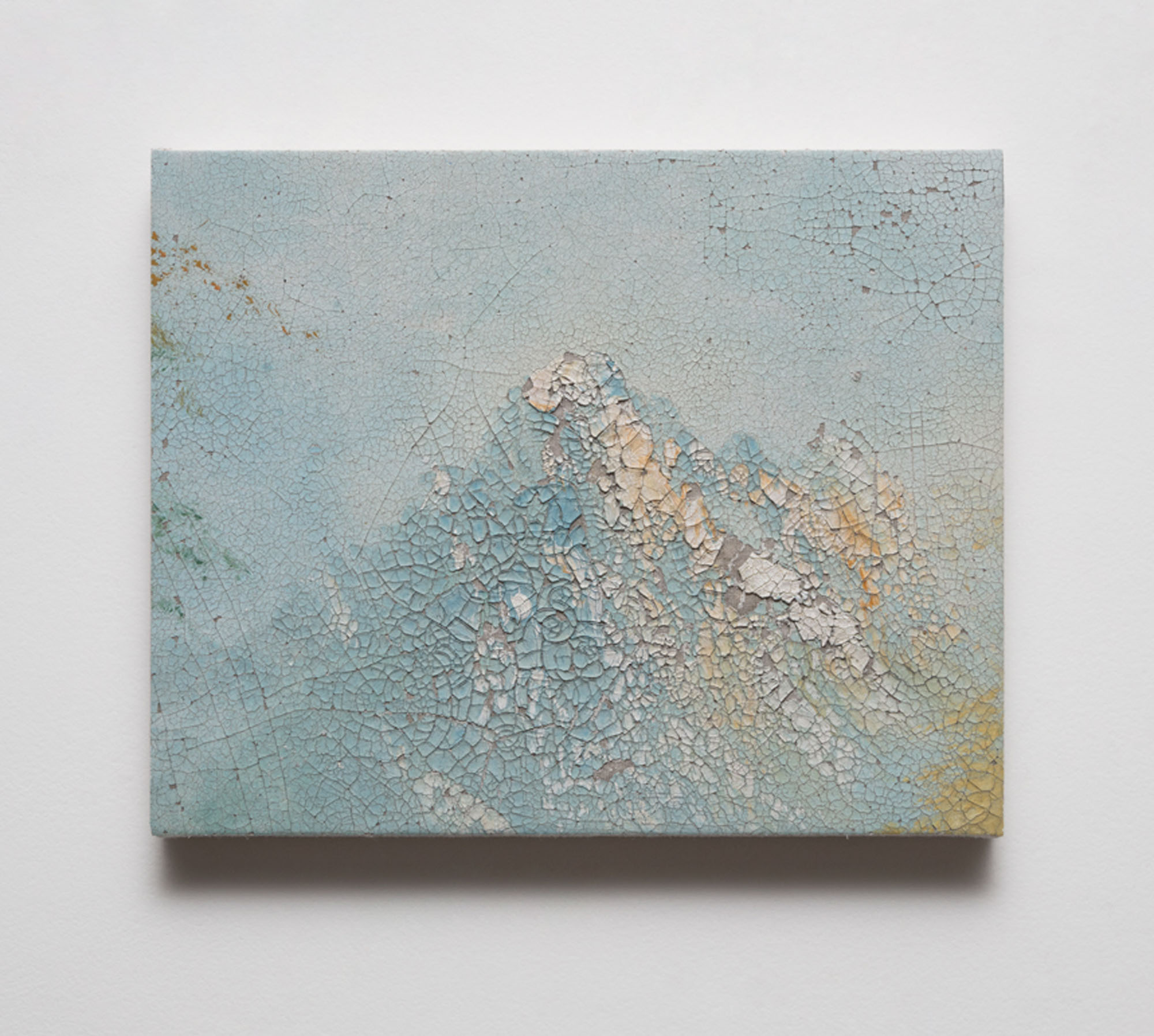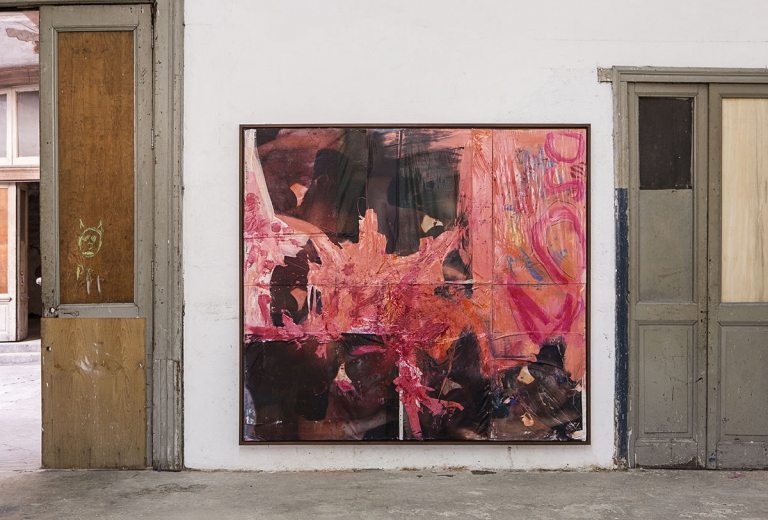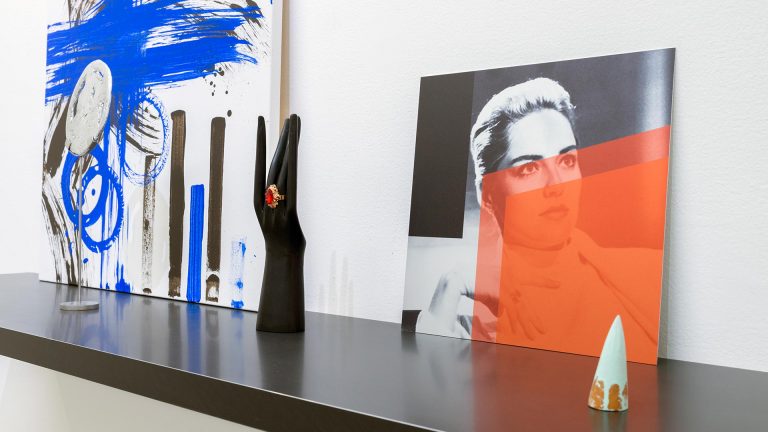Artists: Sofie Muller, Gabriel de la Mora
Exhibition title: Pentimento
Venue: Proyectos Monclova, Mexico City, Mexico
Date: September 6 – November 2, 2019
Photography: all images copyright and courtesy of the artists and Proyectos Monclova, Mexico City
Every era tends to decree the death of painting, whose cataclysm can be extended to the homily of the death of art and of history. Emil Cioran warned about our inveterate habit “of putting apocalypse above cosmogony, of idolizing the explosion and the end, of banking to an absurd degree on the Revolution or the Last Judgment.”[1] The twentieth century and its avant-gardes, many of which were brutal enemies of representation, ferociously attacked painting, abolishing any narrative element in it in dogmatic anticipation of its imminent death. In this sense, abstract painting in the new, technology-dominated millennium can be understood as another entry in the litany of modern resuscitations. Thus, in the face of the dissolution of manual language, the eternal return of painting appears as a reformist counterpart in a cycle of perennial indetermination.
Gabriel de la Mora (Mexico City, 1968) has made use of the randomness of the weather to generate erasures in a bulky series of readymade paintings of different sizes. De la Mora acquired them from different amateur artists, some signed and others whose authors are unidentified. These paintings represent mountains and have been submitted to the relentless action of nature. After exposing them to the elements on a rooftop terrace —some for a few months, others for over a year— the oil and acrylic pigments as well as the pictorial forms have lost their integrity. Further still, this method of subtractive plein air painting presents the effects of erosion as a calm return to chaos and dissolution, no longer accompanied by the prophetic arrogance of those who announce the end of painting or art in absolute terms. Regarding his choice of a theme that is as vulnerable as it is tied to the great names of painting, De la Mora points out that his poetic gesture is an attempt to superimpose the limits of the medium onto those of nature itself. And this return to dissolution constitutes a modern dilemma that is resolved in the opposition between the handmade and the mass-produced. But here this antagonism involves an unusual quest for the primordial. Perhaps the artist enjoins us to return to the origin of representation, visible in the remaining abstractions of the devastation of painting, comparable to the processes that take place after the violent genesis of rocks and minerals, when they are transformed into “algebra, vertigo, order,” so fascinating to Roger Caillois.[2]
The sculptures that Sofie Muller (Ghent, 1974) has made with eroded alabaster and stones from India are presented, by contrast, as surgical interventions on dilapidated objects. Her anthropomorphic figures correspond to body parts: primarily battered, perforated, broken or otherwise incomplete faces and hands. Muller places them sans pedestal next to implements used in sculpture and utensils from medical practice. Her body of work also includes drawings made using her own blood on alabaster, in which she emphasizes the decay and infirmity of the human condition. But what existential evil do these drawings disclose? The artist chooses to define a sort of “human engineering,” a sort of suffering that recalls the tribulations of Mary Shelley’s modern Prometheus. On the other hand, she also alludes to the apparatus of the sculptor’s workshop, one of the great themes from the archaeology and history of ancient art, comparable, perhaps, to the pictorial representation of a mountain for modern art. But the context for a deep understanding of this reference is autobiographical. The daughter of antiques dealers in Belgium, Muller grew up around ancient objects, the memories of which are now part of her research process. One could draw a quick morphological affiliation between these bits of eroded stone and body parts and the sculptural work of Louise Bourgeois, whose feminist appropriation of the surrealist imaginary nevertheless operates along an abject line that is radically different from Muller’s. Judging by the artist’s statement, the three-dimensional works she presents alongside her blood drawings are symptoms of the limit of the human.
Curiously, Gabriel de la Mora and Sofie Muller chose to designate their exhibition at Proyectos Monclova with the title Pentimento. The word comes to us from Italian, and is used in the historiography of art to name a hidden painting that lies underneath several layers of paint. This title provides the show with the possibility of generously visualizing an act of private creation that had either been discarded, repressed or (self-) censored.
[1] M. Cioran, “Caillois: Fascination of the Mineral,” in Anathemas and Admirations, trans. Richard Howard (New York: Arcade Publishing, 1991), 205.
[2] Ibid, 206.
Sofie Muller, Gabriel de la Mora, Pentimento, 2019, exhibition view, Proyectos Monclova, Mexico City
Sofie Muller, Gabriel de la Mora, Pentimento, 2019, exhibition view, Proyectos Monclova, Mexico City
Sofie Muller, Gabriel de la Mora, Pentimento, 2019, exhibition view, Proyectos Monclova, Mexico City
Sofie Muller, Gabriel de la Mora, Pentimento, 2019, exhibition view, Proyectos Monclova, Mexico City
Sofie Muller, Gabriel de la Mora, Pentimento, 2019, exhibition view, Proyectos Monclova, Mexico City
Sofie Muller, Gabriel de la Mora, Pentimento, 2019, exhibition view, Proyectos Monclova, Mexico City
Sofie Muller, Gabriel de la Mora, Pentimento, 2019, exhibition view, Proyectos Monclova, Mexico City
Sofie Muller, Gabriel de la Mora, Pentimento, 2019, exhibition view, Proyectos Monclova, Mexico City
Sofie Muller, Gabriel de la Mora, Pentimento, 2019, exhibition view, Proyectos Monclova, Mexico City
Sofie Muller, Gabriel de la Mora, Pentimento, 2019, exhibition view, Proyectos Monclova, Mexico City
Gabriel de la Mora, 482 días VI, from the series The sense of possibility, 2019, Eroded and consolidated oil on canvas, Dimensions: 7.87 x 9.84 x .79 in, 20 x 25 x 2 cm
Gabriel de la Mora, 482 días XIV, from the series The sense of possibility, 2019, Eroded and consolidated oil on canvas, Dimensions: 7.87 x 9.84 x .79 in, 20 x 25 x 2 cm
Gabriel de la Mora, 445 días VI, from the series The sense of possibility, 2019, Eroded and consolidated oil on canvas, Dimensions: 9.84 x 15.75 x .79 in, 25 x 40 x 2 cm
Sofie Muller, AL/64/18, 2018, Hand carved alabaster, Overall dimensions: 11.81 x 9.45 x 9.45 in, 30 x 24 x 24 cm, 26.7 Kg
Sofie Muller, Untitled (detail), 2019, Hand carved alabaster, Overall dimensions: 11.02 x 9.84 x 6.69 in, 28 x 25 x 17 cm, 5.5 Kg
Sofie Muller, Alabaster drawing, 2019, Human blood on alabaster, Dimensions: 11.81 x 8.27 x .79 in, 30 x 21 x 2 cm






















